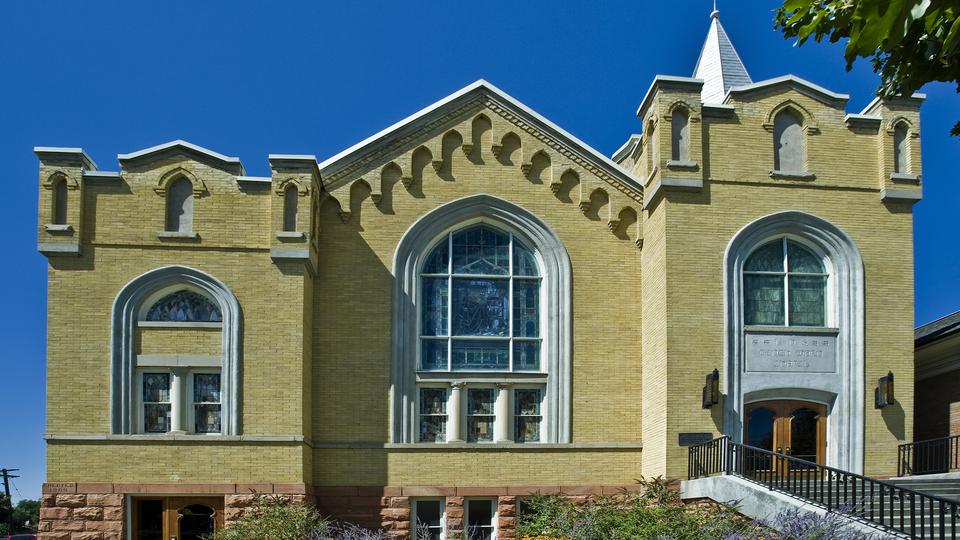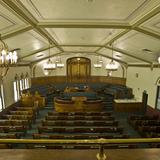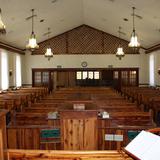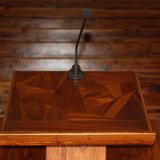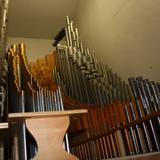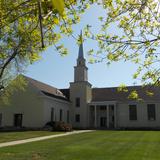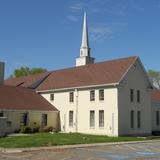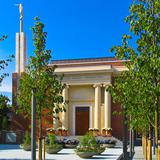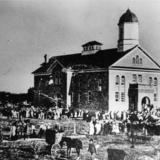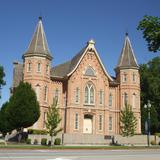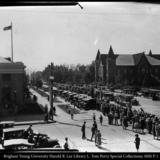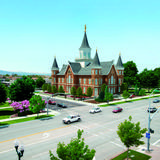The bricks, mortar and beams of a meetinghouse create a level of emotional connection for members of the Church of Jesus Christ of Latter-day Saints who gather there. Significant personal moments in life are experienced by families in these church buildings, such as births, baptisms, celebrations, achievements, even funerals. They also provide the locale for fellowship among Latter-day Saints.
The late Church President Gordon B. Hinckley described his first recognition of the Church’s founder, Joseph Smith, as he listened to a hymn in the old 10th Ward meetinghouse in Salt Lake City. “During the singing in the service,” President Hinckley explained, “there came into my young heart a great surge of love for and belief in the mighty prophet of this dispensation.”
| 1909 Gothic Revival exterior of the 10th Ward chapel in Salt Lake City, Utah 2012 Intellectual Reserve, Inc. All rights reserved. | 1 / 16 |
President Dieter F. Uchtdorf, a counselor in the current First Presidency, recalled a youthful assignment to provide the physical power to pump the organ bellows during his German Latter-day Saint services. He describes his Church attendance “in humble back rooms, in impressive villas and in very functional modern chapels. All of these buildings, “according to President Uchtdorf, “had one important factor in common: The Spirit of God was present — the love of the Savior could be felt as we assembled as a ward or branch family.”
Such feelings of love and respect not only provide for teaching experiences in the doctrine of the Church, but also extend to the valued meetinghouses as well.
The Rock Church in Cedar City, Utah, is a contemporary example of that long-term respect.
Built in 1931 and identified by some as a Depression-era Works Project Administration (WPA) project, the building was constructed entirely with local materials. The benches, railing and doors were fashioned from local juniper trees, harvested in the winter when the sap content was lower. Some of the stones were hauled from other parts of southern Utah, Arizona and Nevada. German immigrant masons arranged the stone pattern on the ground before laying it on the building. Locally mined iron provided the light fixtures.
The Cedar City building underwent a restoration project that was completed in 2012. “The building had some maintenance issues and previous projects hadn’t always been completed to keep the unique history of the building apparent,” explained Emily Utt, curator of historic sites for the Church. “The 2012 restoration project provided seismic upgrades, repaired damaged areas of the building and restored some areas that had been hidden for decades. These projects go almost unnoticed by Church members but greatly extend the life of the building. One of the greatest praises we can receive as stewards of these buildings is to hear that people aren’t quite sure what was changed.”
Many of these early pioneering construction projects represent a “one-of-a-kind endeavor, “ says Jared Doxey, director of architecture, environmental and construction projects for the Church. “They include some unbelievable examples of pioneer workmanship — hand hewn beams — and you see the tireless efforts of those dedicated workers.”
An 1877 meetinghouse in the northern Utah community of Paradise, for example, harkens back to building skills donated by early settlers in the Cache Valley. But, after careful analysis and discussion locally and at Church headquarters the building was deemed seismically unsound combined with a roof that is structurally unsafe. It is scheduled for demolition, which includes salvaging and recycling much of the material. One example of this is the repurposing of the building's unique bell tower. The newly designed chapel in the community will incorporate some of the original stone and a replica of the bell tower.
In Salt Lake City, the 10th Ward building stands as an example of one of the city’s original 19 ward structures. It was constructed as a multipurpose center — a meetinghouse, a school and a church — three separate buildings in the same block that were completed in 1909. Restoration of these buildings was completed in 2000 — a thorough process that implemented the use of old photos to re-create the historic features of the buildings but also allowed for repurposing some of the original square footage.
Currently, restoration work is ongoing with the 1930 original Mission Revival meetinghouse in El Paso, Texas. “It may not be a 100 percent practical effort in El Paso,” Doxey says, “but sometimes history outweighs economy. It’s a significant building for the members in El Paso, as the first Church building in the state.”
Though numerous historic meetinghouses receive that type of recognition, the construction of LDS Church buildings must serve multiple functions.
“Buildings need a purpose, a compelling purpose,” explains Jennifer Lund, manager of Church historic sites. “Church programs have changed over the years, and sometimes it is hard to imagine how an older building can be used to accommodate current needs.”
“Educating a local congregation that a building will still fit your programs is a part of the process,” adds Utt, the historic sites curator. “All of the critical elements exist in a retro-fitted building even though it looks different than a modern church.”
The historians cite the example of the Copenhagen Denmark Temple as a Church building repurposed.
“That Danish meetinghouse, when originally built in 1931, was an important architectural statement in a major European city. It was a local treasure,” Lund said. “Rather than risk it becoming a blight on the community as it aged, it was refurbished and opened in 2004 as the Church’s temple in that Scandinavian land.”
A similar practice has been applied in the reconstruction of the respected Uintah Tabernacle in Vernal, Utah. A contemporary-functioning temple was built inside the exterior shell of the original 1907 structure and dedicated in 1997.
After a devastating fire destroyed much of the beloved Provo Tabernacle in December of 2010, Church President Thomas S. Monson announced, in October 2011, that the building would also be restored and added to the roster of functioning temples across the world. “In many ways,” suggests Utt, “it would be easier to tear down the shell of the Provo Tabernacle and start over with a brand new building, but the decision was made to restore the building instead because it provides a tangible connection to Provo’s pioneer past.”
Function and economy stand as the significant criteria in Church meetinghouse construction, Doxey adds, as he explains the historical development of building gathering places of worship in the Church.
“In the early days of the Church, members rallied to design and build a local meetinghouse, utilizing their readily available local resources,” Doxey explains. “It wasn’t until about 1920 that the Church retained architects and suggested local building designs, but these were still optional to individual congregations. It was not until after World War II that the Church issued recommended floor plans, but even then, a measure of local influence prevailed until the funding patterns changed. In 1982, standard designs were implemented, designs that meet all local building requirements, satisfy seismic codes and are paid for by the central Church funds.”
In the current building program of the Church, despite economic downturns, the Church continues to construct or refurbish chapels for the growing membership of the Church, Doxey added. Efforts to employ the most economical building standards prevail, but consideration is currently given to sustainable designs that provide more energy efficient and environmentally beneficial building designs as well as historical conservation concerns.
“Even if the congregation in an area has 50 faithful members and meets all the qualifying criteria,” Doxey explained, “we will build a functional building for Church services. It doesn’t matter whether Latter-day Saints live in Harlem or Hollywood, in Scottsdale or the DR Congo, they will be blessed to learn and worship in a beautiful church.”
